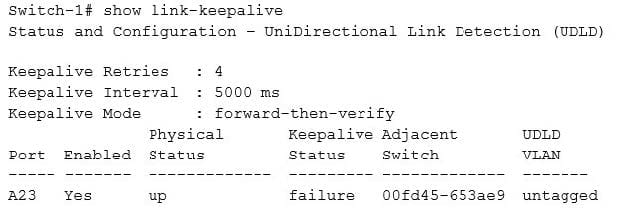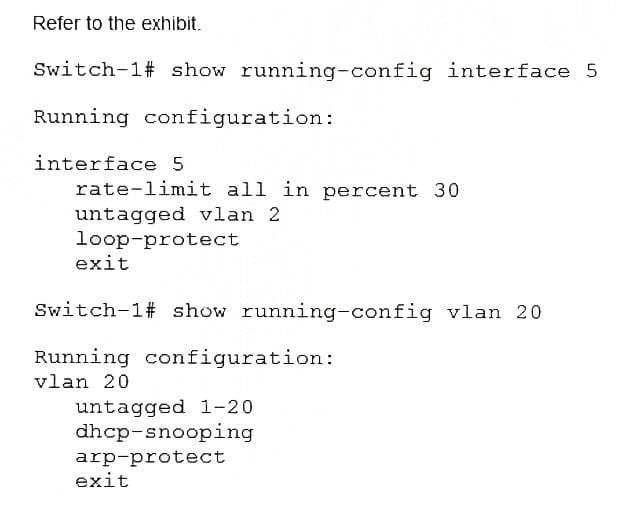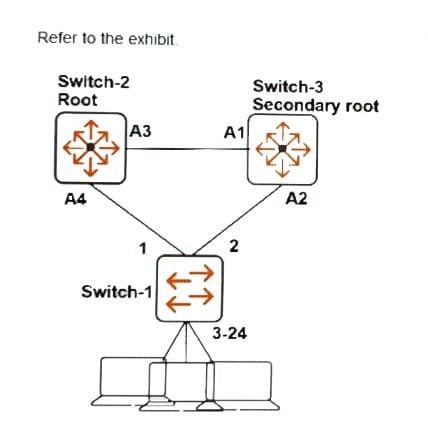Exam Details
Exam Code
:HPE6-A45Exam Name
:Implementing Aruba Campus Switching solutionsCertification
:HP CertificationsVendor
:HPTotal Questions
:168 Q&AsLast Updated
:Mar 30, 2025
HP HP Certifications HPE6-A45 Questions & Answers
-
Question 131:
What is a reason to implement PIM-DM as opposed to PIM-SM?
A. to control exactly which multicast groups are routed through the network
B. to permit a higher density of RP routers in the network core
C. to conserve bandwidth over WAN links
D. to use on high-bandwidth routed connections
-
Question 132:
An AOS-Switch enforces 802.1X. It receives an Access-Accept with this HPE VSA from its Radius server: Attribute Name and ID = HPE-User-Role (25) Value = contractor
The switch then rejects the client. What is one requirement for the switch to accept the message and authorize the client?
A. The initial user role must be set to the factory default permit any role.
B. User role authorization must be enabled globally on the switch.
C. An aaa authentication local user group must have the contractor name.
D. The RADIUS server settings must permit dynamic authorization.
-
Question 133:
Refer to the exhibit.

Switch-1 and Switch-2 connect on interface A23. The switches experience a connectivity issue. The network administrator sees that both switches show this interface as up. The administrator sees the output shown in the exhibit on Switch-1.
What is a typical issue that could cause this output?
A. asymmetric routing introduced by a routing protocol
B. an issue with VLAN mismatch
C. mismatched subnet mask on the VLAN for the link
D. a jumbo frame mismatch
-
Question 134:
Refer to the exhibit.

The exhibit shows configurations for interface 5 and VLAN 20. Note that DHCP snooping and ARP protection are also enabled.
A network administrator finds that interface 5 on an AOS-Switch is disabled. The administrator re-enables the interface, but it shuts down again.
What should the administrator investigate?
A. a device that sends too much unicast traffic
B. rogue DHCP server
C. a loop on the interface
D. a device that sends unauthorized ARP messages
-
Question 135:
What is one difference between BPDU protection and root guard?
A. BPDU protection works with RPVST+, RSTP, and MSTP. Root guard works with RSTP or MSTP, but not RPVST+.
B. BPDU protection blocks a port if it receives any BPDU, but root guard blocks a port only if the BPDU indicates a better root path.
C. BPDU protection is typically implemented on edge ports, but root guard is typically implemented on uplinks with the root port role.
D. BPDU protection drops BPDUs received on a port, but does not block the port. Root guard blocks the port if it receives a BPDU.
-
Question 136:
A network administrator configures DHCP snooping on VLAN 2. How does the switch handle DHCP traffic that arrives in this VLAN on an untrusted interface?
A. It accepts packets from a DHCP server, but drops client packets.
B. It drops all DHCP traffic and logs a security event.
C. It accepts both client and server packets as long as they match the DHCP binding table.
D. It accepts client packets, but drops packets from a DHCP server.
-
Question 137:
Refer to the exhibit.

A network administrator wants to add the protections of root guard to the network. Based on the spanning tree topology, on which ports should the network administrator implement root guard?
A. 3-24
B. 1 and 2
C. A1 and A2
D. 2 and A3
-
Question 138:
The implementation plan for AOS-Switches calls for them to implement port-based tunneled node. The Aruba Mobility Controllers that will support the AOS-Switches run software 8.1. The controllers will also support APs, are managed by Mobility Master, and use clustering.
Which issue with this plan needs to be addressed?
A. The controllers cannot support tunneled node with AOS-Switches when they are managed by the Mobility Master.
B. The switches cannot connect to controllers that also support APs.
C. The controllers must have their software updated before they can support the switches.
D. The switches must use role-based tunneled node to work with clustering controllers.
-
Question 139:
A company deploys AOS-Switches at sites with inexperienced IT staff. The main office network administrators want to monitor thresholds to generate alerts on branch switches.
What should be set up for this purpose?
A. an SNMP trap
B. an RMON alarm
C. an auto-config server
D. an sFlow instance
-
Question 140:
A network administrator needs to create a backplane stack with four AOS-Switches. The administrator wants to choose which switch becomes the commander.
Which procedure meets those needs?
A. Boot all of the switches at the same time and then connect the backplane stacking links. Then, access the desired commander, and make sure it has member ID 1.
B. Configure backplane switches settings on each switch while disconnected. Make sure the desired commander has priority value 1. Then, connect the switches.
C. Boot up the desired commander first and make sure stacking is enabled on it. Then, connect the stacking links and boot the other switches.
D. Configure backplane switching settings on each switch while disconnected. Make sure the desired commander has member ID 1. Then, connect the switches.
Related Exams:
HP0-D15
Administering HP CloudSystem Matrix SolutionsHP0-D20
Architecting the HP Matrix Operating EnvironmentHP2-E56
Selling HP SMB SolutionsHP2-H88
Selling HP Business Personal Systems Hardware 2019HP2-I14
Selling HP Supplies 2020HP2-I15
Selling HP Business Personal Systems Hardware 2020HP2-I17
Selling HP Printing Hardware 2020HP2-I44
Selling HP Workstations 2022HP2-I73
Selling HP Retail and Hospitality Solutions 2024HP2-N51
HP Application Lifecycle Management 12.x Software
Tips on How to Prepare for the Exams
Nowadays, the certification exams become more and more important and required by more and more enterprises when applying for a job. But how to prepare for the exam effectively? How to prepare for the exam in a short time with less efforts? How to get a ideal result and how to find the most reliable resources? Here on Vcedump.com, you will find all the answers. Vcedump.com provide not only HP exam questions, answers and explanations but also complete assistance on your exam preparation and certification application. If you are confused on your HPE6-A45 exam preparations and HP certification application, do not hesitate to visit our Vcedump.com to find your solutions here.